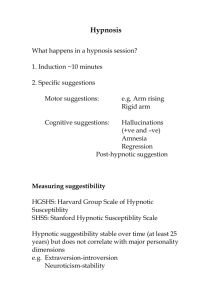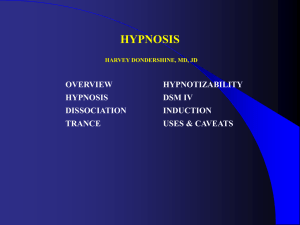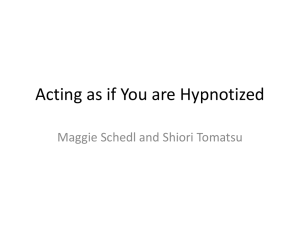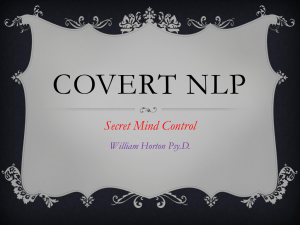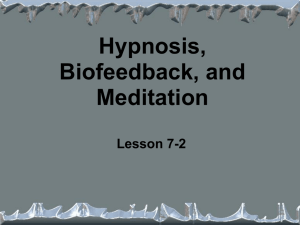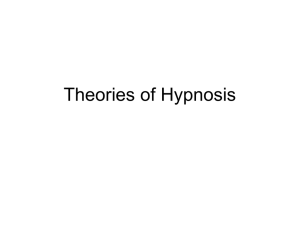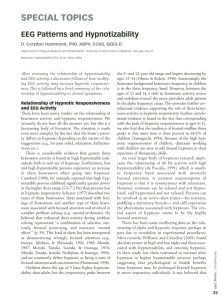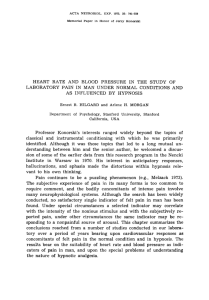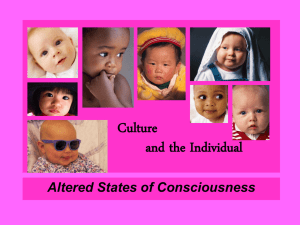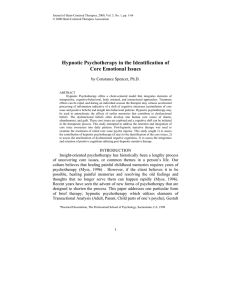Hypnosis_French
advertisement
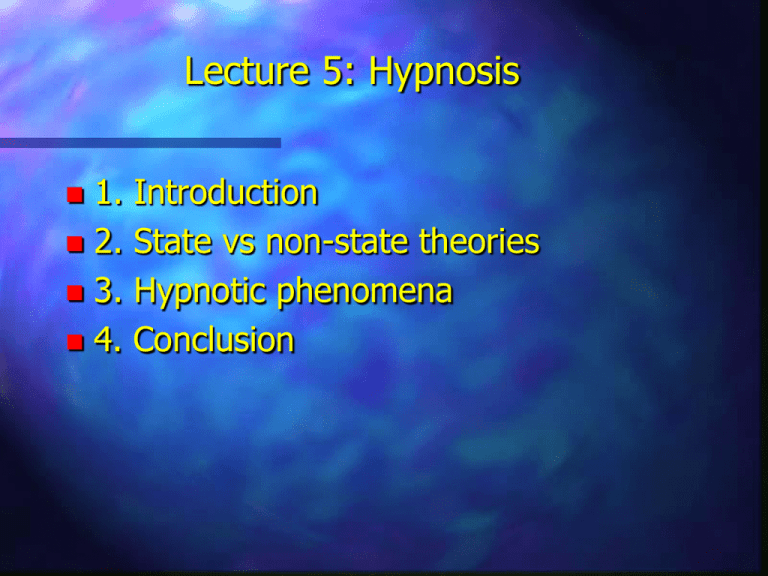
Lecture 5: Hypnosis 1. 2. 3. 4. Introduction State vs non-state theories Hypnotic phenomena Conclusion A strange and powerful force? Franz Anton Mesmer 1734-1815 Mesmerist with patient Mesmer’s Baquet Mesmer’s Baquet Deslon fails to magnetise Franklin The Royal Commission’s Report Presentation of the Report James Braid 1795-1860 Braid’s Method Braid’s Report State Theories of Hypnosis View hypnosis as a unique altered state of consciousness Different levels of trance – the deeper the trance, the wider the range of hypnotic phenomena which manifest E.g., Hilgard’s neodissociationist model – multiple systems of control, not all conscious at the same time – hypnosis removes control from “executive ego” Neodissociationist Theory Hidden observer phenomenon analgesia, regression, deafness, blindness, amnesia, hallucinations, and so on. Non-State Theories: Psychological Concepts Hypnosis explained in terms of:‘attitudes, expectancies, beliefs, compliance, imagination, attention, concentration, distraction, and relaxation’ (Wagstaff 1994) Hypnosis as role-playing (Barber, Spanos and Wagstaff): 1. The subject works out what is expected on the basis of previous knowledge and current instructions. 2. The subject employs various strategies to bring about the desired results. 3. If the strategies are unsuccessful, the subject gives up or else fakes it. (Wagstaff 1991) Control Groups in Hypnosis Studies Simulators vs “reals” (e.g., Orne, 1979) Task-motivated participants (e.g., Barber, 1969) Hypnotic Phenomena No characteristic pattern of psychophysiological activity uniquely associated with “hypnotic trance” Paranormal claims – seeing with the back of the head – reading while blindfolded – communicating with the dead – clairvoyance – past-life regression Reading while blindfolded Clairvoyance: Knowing who is at the door before they enter Hypnotic Phenomena Memory enhancement – no more effective than other techniques and risks encouraging confabulation (e.g., Wagstaff, 1989) Improved strength, e.g., human plank demonstration Human Plank Hypnotic suggestion Cold, isn’t it? Or is it rather hot? Hypnotic Paralysis and Hysterical Convulsions? Dangerous and Antisocial Acts Non-state account emphasises participants – wanting to help the hypnotist/experimenter – thinking that their actions were actually safe – making assumptions that someone else would take responsibility for the consequences of the acts Trance Logic (e.g., Orne, 1959, 1979) If asked to hallucinate a person who is already present “reals” will report seeing both the actual person and the hallucinated double simultaneously if asked to hallucinate a person sitting in a chair, “reals” will report that they can see through the image Trance Logic (cont.) When regressed to childhood, “reals” will report that they feel simultaneously like a child and an adult In such a state, “reals” will correctly write complex sentences. In all these situations, simulators behave in a more logically consistent manner Trance Logic: Non-state Explanation Simulators are told to behave like excellent hypnotic subjects (Wagstaff, 1999) Negative hallucinations – Participants just lying (Wagstaff)? – Spanos, Flynn & Gabora (1989) An example of negative hallucinations? Hypnotic Amnesia Neodissociationist explanation: Hypnotic suggestion produces “amnesic barrier” which can be breached if release signal given Non-state explanation: Instruction to forget is interpreted as instruction to try not to remember Interference effects still found Psychophysiological indices of familiarity still manifest Attempts to “breach amnesic barrier” often successful Hypnotic Analgesia Hypnotic Analgesia (Wagstaff, 1994) ... first, cases of surgery with hypnosis alone are rare, and some individuals can tolerate pain without medication or hypnosis; second, much major surgery is actually less painful than is commonly expected; and third, pain is a complex sensation that can be alleviated through relaxation, the reduction of stress and anxiety, and the use of strategies such as distraction and the reinterpretation of noxious stimulation; all of which are frequently involved in cases of hypnotic surgery (Chaves, 1989; Spanos & Chaves, 1989). Hypnotic Analgesia Reflects expectations of participants As does perception of pain reported by “hidden observer” Hypnotic Phenomena Clinical applications Age regression Age progression Past-life regression Hypnotic Progression to the Future! Conclusion Although debate continues, non-state theorists are able to offer plausible accounts for hypnotic phenomena … … which is a bit of a pity as state theories could potentially explain a wide range of ostensibly paranormal phenomena! Acknowledgement With thanks to Hilary Evans, proprietor of the Mary Evans Picture Library, for permission to use illustrations featured in this presentation. These illustrations must not be reproduced in any form without permission from the Mary Evans Picture Library.
